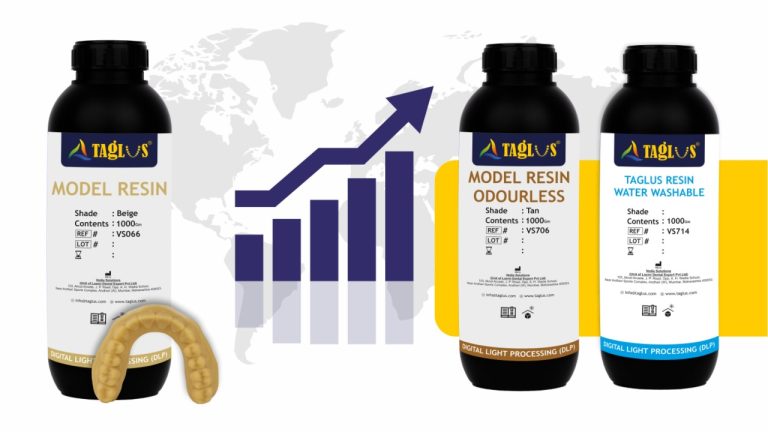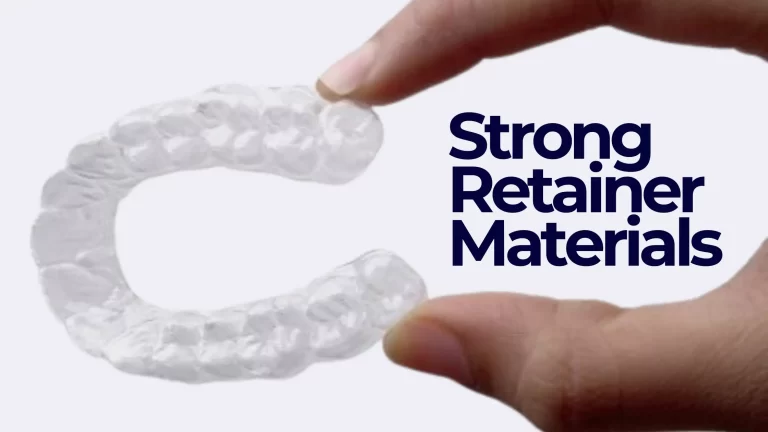Enquire Form
The Rise of 3D Printing Dental Resin

Dental Plaster and Dental Stone have been used for decades to make dental models. The dental model produced using such traditional methods had several issues, including inaccuracies, long-term wear and lengthy fabrication methods.
The introduction of 3D Printing has completely transformed the normal workflow in Dentistry. The resins are formulated to produce detailed and precise models. It has offered a faster and more productive alternative to the traditional way of producing dental models. This advancement provides speed, ease of operability and accuracy. It helps in dealing with complex cases effortlessly, such accuracy was difficult to attain using traditional methods.
What is 3D Printing Resin?
3D Printing Dental Resins are used for resin-based 3D Printing of dental appliances. They provide detailed and accurate models with smooth surfaces, making them a good alternative when high accuracy and precision are required. Over time, the formulations using 3D Printing Dental Resin have dramatically evolved, and today one can avail a range of formulations for dental models, prototypes, and functional parts with improved stability, flexibility, and biocompatibility. Equipped with superior advantages, now, they have become the first choice for any dental expert around the world. 3D Printing Dental Resins are forcing many dental experts to switch over entirely to a fully digital dental workflow.
What Are the Benefits of 3D Printing Resin?
As we are rapidly advancing in the field of dentistry, it becomes important for us to explore every possible way to reap maximum benefits from our dental workflow. The addition of high-quality 3D Printing Dental Resins greatly increases the efficiency of the digital workflow. It produces high-quality dental models that fulfil the most common needs of a dental professional.
Some of the benefits offered by dental models generated with the help of 3D Printing Dental Resins are as follows:
High Precision
When it comes to capturing fine features and complex geometries of a dental model, no comparison can be drawn to models prepared with the help of 3D Printing Dental Resins as they successfully replicate the structure of the mouth.
Smooth Surface Finish
The dental model produced from 3D Printing Dental Resins offers a smooth surface finish, reducing the need for post-processing, which may be necessary in conventionally produced dental models.
Efficiency
3D Printing Dental Resins reduces the time to produce dental models and appliances. It helps a dental professional reduce the turnaround time and enhance the efficiency of the work process.
Cost-effectiveness
3D Printing reduces material waste and saves the cost of inventory. It involves the manufacturing of a dental model with the help of a digital process. It reduces the labour involved in the process, making it cost-effective.3
Durability
Models made from 3D Printing Dental Resins show very high mechanical strength. Thus, the models possess extraordinary durability.
Traditional Method Versus 3D Printing Dental Resin
Traditional Method
This includes taking the physical impression of the patient, followed by casting the model. It can be quite time-consuming, and there are more chances of producing errors. Such processes involve a lot of material wastage and several steps for customisation.
3D Printing Dental Model Resin
These models are built from a digital impression. This offers high precision and accuracy. It simplifies production and enhances personalization with minimal material wastage.
Properties
The following peculiar qualities are present in 3D Printed Dental Resin models:
- High Resolution and Accuracy: Fine detail and precision, help a dental professional produce a detailed model.
- Mechanical Strength: Good tensile strength, flexural strength, and resistance to impact force are present in 3D Printed Dental Models.
- Resists Wear: Smooth and high-quality surfaces resist wear from chemicals and environmental factors, ensuring long-lasting performance.
- Biocompatibility: Conforms to safety for direct contact with human tissues, important in dental applications.
- Colour and Transparency: Available in various colours for aesthetic and functional customisation.
Integration in Digital Dentistry Workflow
The process of 3D Printing is also known as Rapid Prototyping or Additive Manufacturing. It forms a major component of digital dentistry. The addition of 3D Printing Dental Resins makes the process all the more precise and efficient.
Firstly, an intraoral scanner is used to perform an oral scan of the particular areas of the patient’s mouth. With the help of the scan, the 3D model is made digitally. Once the digital model is prepared, the custom-made dental model is printed out with the help of 3D Printing Dental Resins.
The digital method minimises the need for physical models and reduces manual work, hence speeding up production. It results in proper fitting restorations, and patients receive faster service, making the process smooth and effective.
The Future of 3D Dental Model Printing
Taglus is a leading manufacturer of innovative thermoforming solutions bringing efficiency to the digital workflow of dentistry. Taglus 3D Printing Model Resins is one of our advanced products which is a methacrylate resin made for the DLP printers with 385 nm/405 nm LED & LCD system.
It is a high-precision resin which offers an ideal solution for the production of highly accurate models. The dental models produced using Taglus 3D Printing Resins have a smooth matte surface finish, with high break stability, abrasion, moisture and light resistance.
Taglus 3D Printing Dental Resins can be used for: 3D printing of crown and bridge models, orthodontic models, clear aligner models, diagnostic models, implant models, surgical guides and castable splints.
Taglus 3D Printing Dental Resins come in two different varieties. Taglus Water Washable & Taglus Odourless 3D Printing Dental Resins. Let’s discuss the benefits of both types in detail:
- Taglus Water Washable 3D Printing Dental Resin: The models produced from Taglus Water Washable dental resin can be easily cleaned with distilled water. Traditional resins usually require IPA washing to attain a residue-free clean surface. However, with Taglus Water Washable resin there is no such requirement.
Benefits:
a. Convenience: Post-processing of dental models already has multiple steps. Water Washable Dental Resin simplifies the post-processing of models by eliminating the step of cleaning the dental models. Cleaning models with water saves time and offers convenience. In high-production environments like dental labs or aligner manufacturing setups, reducing post-processing time per model can enhance overall efficiency and output.
b. Lesser Expense: There is a distinct difference in terms of the expense associated with buying distilled water and IPA, with IPA being on the expensive side. For large-scale production, this cost can add up quickly, thus switching to a water-washable resin is a better choice.
c. User-Friendly: Taglus Water Washable Dental Resin reduces the dependency on strong chemicals which are required for cleaning the models. Chemicals like IPA are flammable and usually require strict management to avoid potential chemical hazards. Using Taglus Water Washable Dental Resin would reduce the expenses related to the purchase, storage and handling of strong chemicals because of its delicate properties.
d. Easier Waste Disposal: Unlike IPA-based resin waste, which would require you to follow proper hazardous waste disposal protocols, water-washable resin waste is easier to manage. Since it can be rinsed with water, the post-processing byproducts are less hazardous compared to IPA-contaminated waste.
e. No Compromise in Quality: Taglus Water Washable Dental Resin maintains the same high level of precision as compared to resins involving IPA washing. It maintains the quality of the products ensuring accuracy in the models. The material offers comparable mechanical properties, including strength and durability, to traditional resins, making it suitable for various dental applications. Increased wash time can have a negative impact on the mechanical properties of the models. The use of distilled water allows the highest degree of cleanliness and safety for the dental professional and the patient while saving time & maintaining the quality of the model.
Precautions:
Distilled water washing produces little hazardous waste, but it is still important to wash the printed models and discard the water as per the appropriate protocol. The water would still contain a certain amount of resin residue which cannot be handled similarly to normal water.
- Taglus Odourless 3D Printing Dental Resin: 3D Printing Dental Resins usually come with a strong chemical smell which spreads across the room once you start using it. Taglus Odourless 3D Printing Dental Resin is specially designed to provide a more comfortable working environment in your lab or clinic by eliminating these strong odours. An odour-free and pleasant workplace gives a better patient experience. It also helps your staff by maintaining a distraction-free and healthier work environment.
Benefits:
a. Odour-Free Experience: Conventional 3D printing resins tend to produce strong, irritating odours when printing. Such a type of odour can make the working environment uncomfortable, particularly in enclosed spaces. Taglus Odourless Dental Resin solves this issue. It creates an odour-free working environment that improves user comfort. It solves the problem of using large & costly ventilation systems.
b. Improved Workplace Safety: Since there is no pungent chemical smell, it ensures a healthy and safer working environment. Chemical smell can be very problematic for individuals who have respiratory issues. It may also cause irritation in some people. These issues can be prevented in the case of odourless resins.
c. High Precision and Accuracy: There is no compromise in performance with Taglus Odourless 3D Printing Dental Resins. Dental models produced using Odourless 3D printing resins possess high dimensional accuracy and excellent surface finish. Each case has a unique requirement, and Taglus Odourless 3D Printing resins make sure they are met successfully. The models produced using this resin possess optimal mechanical properties which makes it useful for various dental applications.
d. User-Friendly Formulation: While using Taglus Odourless Dental Resin, you will not need any additional ventilation equipment. The resin is easy to handle and process. This enhances the user experience. This makes it ideal for dental professionals seeking both convenience and safety.
e. Constant Performance: It maintains an odour-free environment even upon continuous operation for hours. This feature makes it extremely reliable and useful for high-output dental facilities like dental labs and aligner production units.
Precaution:
Although Taglus Odourless 3D Printing Dental Resin reduces odour-induced discomfort, a dental practitioner must adhere to routine safety practices while handling and post-processing. It is also important that the operator ensures good storage conditions for resin for its best performance and longevity.
With these novel variants, Taglus continues the tradition of being a leading innovative producer of thermoforming workflow solutions, placing it among the top choices for modern 3D printing of dental models.
For any further information, reach out to us at: https://www.taglus.com/contact-us/
References:
1 – Jeong M, Radomski K, Lopez D, Liu JT, Lee JD, Lee SJ. Materials and Applications of 3D Printing Technology in Dentistry: An Overview. Dentistry Journal. 2024; 12(1):1. https://doi.org/10.3390/dj12010001.
2 – Shim, J. S., Kim, J. E., Jeong, S. H., Choi, Y. J., & Ryu, J. J. (2020). Surface roughness of dental models fabricated with 3D printing techniques. Journal of Prosthetic Dentistry, 124(2), 215-222. https://doi.org/10.1016/j.prosdent.2019.10.013.
3 – Jeong M, Radomski K, Lopez D, Liu JT, Lee JD, Lee SJ. Materials and Applications of 3D Printing Technology in Dentistry: An Overview. Dentistry journal. 2023;12(1):1-1. https://doi.org/10.3390/dj12010001.
4 – Dawood, A., Marti, B., Sauret-Jackson, V. et al. 3D printing in dentistry. Br Dent J 219, 521–529 (2015). https://doi.org/10.1038/sj.bdj.2015.914.
5 – Bhargav A, Sanjairaj V, Rosa V, Feng LW, Fuh Yh J. Applications of additive manufacturing in dentistry: A review. J Biomed Mater Res B Appl Biomater. 2018 Jul;106(5):2058-2064. https://doi.org/10.1002/jbm.b.33961.
6 – Hwangbo NK, Nam NE, Choi JH, Kim JE. Effects of the Washing Time and Washing Solution on the Biocompatibility and Mechanical Properties of 3D Printed Dental Resin Materials. Polymers. 2021;13(24):4410. https://doi.org/10.3390/polym13244410.
Know More About Us
SignUp To Our Newsletter And Get To Know More About Taglus
Copyrights@taglus-2025
*Taglus is a trademark of Vedia Solutions










Leave a Reply